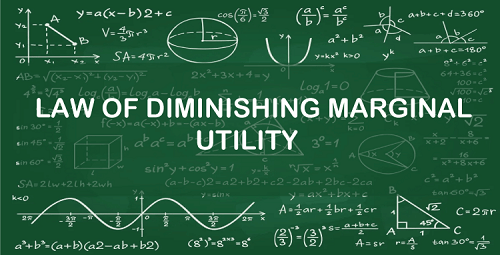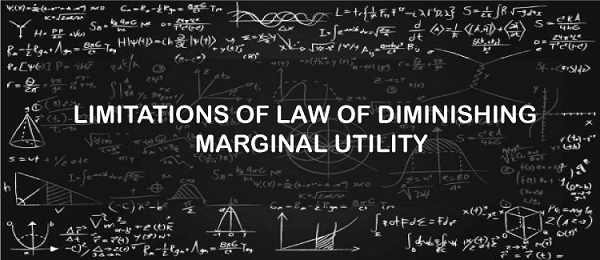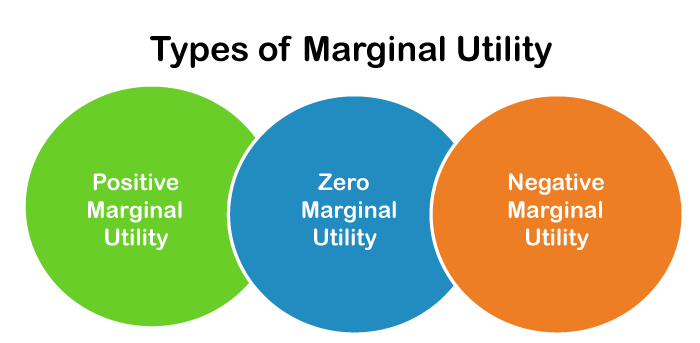Law of Diminishing Marginal UtilityWhat is the Law of Diminishing Marginal Utility?According to the law of diminishing marginal utility, when usage rises, the satisfaction gained from each extra unit decreases, all other things being equal. The incremental improvement in utility brought on by consuming one more unit is known as marginal utility. An economic word used to refer to pleasure, satisfaction, happiness, or contentment is "utility". 
According to the law of diminishing marginal utility, the greater amount of a good you use or consume, the less enjoyment you experience from each subsequent unit. The marginal utility might fall to zero, making it completely disadvantageous to consume any additional units of any product. In-Depth Understanding of the Law of Diminishing Marginal UtilityIt might be beneficial to examine each element of the law of diminishing marginal utility to comprehend how it impacts customers and enterprises. Understanding UtilityThe satisfaction or delight a customer experiences due to economic activity is known as the utility. For instance, a customer can buy a meal to satisfy his/ her hunger. Therefore, food serves some purpose and, in this case, is known as utility. Understanding Marginal UtilityThe pleasure a customer experiences from each extra consumption unit is called marginal utility. It determines the utility after the initial product is consumed. The marginal utility is the benefit derived from the additional (second) water bottle if you purchase it after consuming the first bottle. Understanding Diminishing Marginal UtilityThe idea of declining pricing is intimately related to diminishing marginal utility. Customers are prepared to spend less money for more of a product since its utility declines as its usage rises. Consider, for instance, a $100 vacuum cleaner that someone purchases. The same person may be willing to pay only $20 for an additional or second vacuum cleaner because the second vacuum cleaner is of little value to him. The marginal utility might even become negative. Consider a scenario when consuming any additional units of any product is completely detrimental. Because of this, the initial unit of consumption of any good is usually the highest. The usefulness of each subsequent unit of consumption decreases after that. By consuming a variety of commodities, consumers manage the law of diminishing marginal utility by maintaining high utility levels for all of them. The cost charged by a firm for a product must align with the marginal utility and consumer's desire to have or use the good because these factors are directly responsible for how the law of diminishing marginal utility will affect the firm's product price. Example of the Law of Diminishing Marginal UtilityConsider that the pizza slice is available for $2. Due to your extreme hunger, you get five pieces of pizza. You start to experience some positive utility from consuming when you take the first bite of the pizza. The first piece of pizza has a significant advantage because it is the first thing you consume, and you are hungry. Your hunger will subside after you finish the second piece of pizza. The profit and pleasure of the second piece of pizza were less than the first since you weren't as hungry as before. The third piece has even less value because you're only somewhat hungry. The marginal value of the fourth piece of pizza has also decreased. You may find consuming it challenging because the first three servings have already made you feel full. Eventually, even the fifth piece of pizza is off-limits. The first four pieces of pizza fill you to the point that eating the last slice has no positive benefit. At this point, the marginal utility is considered null or negative. Example of the Law of Diminishing Marginal Utility in BusinessThis idea may be used by businesses to organize their personnel. Three accountants on staff, for instance, can be advantageous for a business. However, if there is no demand for another accountant, employing one another has a lower utility since the new worker only contributes minimal value. The usefulness in adding a new admin assistant is even better than adding another accountant unless you already have auditors but no one to handle the paperwork. The law of diminishing marginal utility, which promotes some variety, can also impact the products and services companies provide to clients. In the previous illustration with the pizza, if the consumers know they won't want to have the fourth or fifth piece, they can decide not to purchase them. However, they can find a different dish, like a salad, quite useful. The pizza business may prevent declining marginal utility and motivate customers to make larger purchases by expanding its menu. Assumptions of the Law of Diminishing Marginal UtilityReasonable ShoppersIt calls for reasonable customer behavior. According to the legislation, customers must maximize utility while considering their incomes. They should always make wise selections. Constant ConsumptionThis premise is essential for the law to be valid. It indicates that the user must continually consume every extra unit of the commodity. As a result, there shouldn't be breaks between consuming other units. For instance, if a ravenous person eats pizza for lunch and then another pizza for the evening, the law is broken since the individual is now twice as hungry and gets more use out of the different pizza than he would have if he had eaten it immediately after lunch. Therefore, gaps in the consumption of extra units are illegal. Standard Unit SizeAll units should have the same size. Since the person hasn't yet gotten the full utility from taking a complete unit of the product, drinking an additional half water glass after the first one may not reduce the utility, it is inconsistent with the rule of diminishing marginal utility to minimize the dimension of units consumed. Exceptions of the Diminishing Marginal UtilityHobbies/AddictionsIn the event of obsessions, this legislation is not applicable. For an alcoholic, the marginal benefit of consuming one more drink does not diminish. Similarly, someone who enjoys painting would not encounter declining marginal value when creating a new work of art. Rare ObjectsThis statement is likewise untrue in the context of unique items. It is particularly true for fanatics who pursue and are concerned about such topics. For instance, a watch fanatic who enjoys accumulating watches and already has a large collection could greatly delight in purchasing more of a limited-edition timepiece. Unfounded PresumptionsThis law makes assumptions that are only sometimes true. A customer can act irrationally; there can be gaps in when a good is consumed, etc. These presumptions may not be met, in which case, the law might not apply. How does this legislation affect pricing?Yes, it is true that the law of diminishing marginal utility influences pricing for products and services. This is because customers are typically prepared to pay extra for the first unit of anything since it has the greatest usefulness. For instance, a business may offer discounts on backpacks, such as one for $30, two for $55, or three pairs for $75. The best price for a backpack may be obtained by purchasing three. Even though three packages are the best value, not all customers will desire them. But since everyone who goes bag shopping requires at least one, the first bag is the most expensive. Following that, the company must reduce the price per unit to persuade customers to buy more items because the marginal usefulness of each subsequent bag diminishes. Limitations of the Law of Diminishing Marginal Utility
The rule of diminishing marginal utility has several restrictions regarding business choices. The legislation may not even be applicable or will not function as intended if:
Additionally, if the currency is the item under consideration, the diminishing marginal utility rule will not apply. Money's usefulness does not diminish as one accumulates more of it. Importance of the Law of Diminishing Marginal UtilityIndividual desires are founded on an intensity trait. The marginal benefit from using each new unit of an item declines as we take more of it successively. The following concepts justify the significance of the Law of Diminishing Marginal Utility:
Types of Marginal Utility
The following describes the various marginal utility forms: 1. Positive Marginal UtilityThe increasing marginal utility resulting from using a good is called positive marginal utility. This effect happens when consuming more of an item gives the customer more pleasure. If you enjoy eating cake, for instance, the first slice will make you feel better. But, suppose the second slice gives extra pleasure than the first slice. Therefore, the marginal value of consuming the cake is positive. 2. Zero Marginal UtilityWhen customers reach their satisfaction threshold, no marginal utility is left to provide. This phenomenon happens when consuming more commodity units doesn't increase the consumer's level of enjoyment. For instance, you can feel full and not want to eat the third piece of cake after having two cake slices. As a result, at this point, the marginal value of eating the third piece of cake is zero. 3. Negative Marginal UtilityThe term describes a marginal utility that diminishes below zero, meaning that after consuming units of the satisfaction level, the consumption of additional units may be harmful. This phenomenon occurs when a buyer consumes more units of a good that is harmed in some way, with each new unit purchased becoming a negative marginal utility. For instance, after using the third piece of the cake, you could feel uncomfortable or even sick eating the fourth, which would have a negative marginal value. The Bottom LineConsumers' responses to a specific supply level may be predicted according to the law of diminishing marginal utility. The usefulness of each unit will decline as they consume more of a single sort of good until they run out of options. Businesses may utilize diminishing marginal utility to gauge customer preferences, set prices for their products and services, and broaden their scope.
Next TopicSeller
|
 For Videos Join Our Youtube Channel: Join Now
For Videos Join Our Youtube Channel: Join Now
Feedback
- Send your Feedback to [email protected]
Help Others, Please Share









